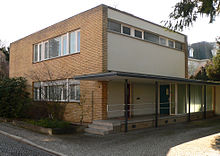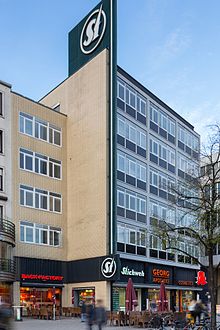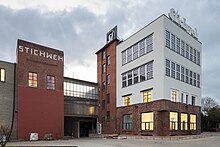Wilhelm Stichweh
Wilhelm Stichweh (born May 11, 1899 in Hanover ; † August 11, 1979 there ) was a German businessman and - similar to Hermann Bahlsen , Fritz Beindorff and Bernhard Sprengel - one of the great patrons of art in the Lower Saxony state capital.
Life
Wilhelm Stichweh was born in Hanover in 1899 during the founding period of the German Empire . He was the son of the entrepreneur Wilhelm Stichweh senior and a grandson of the Stichweh company founder Friedrich August Stichweh . After finishing school at the secondary school studied the "[...] Prussian " law and economics , was briefly on 13 May to 12 August 1919 in Rostock at the local university enrolled in law and a doctorate to Dr. rer. pole. in Göttingen at the Georg August University in 1923 with his dissertation on the history of the dyeing trade in Lower Saxony .
After the death of his father in 1923, Wilhelm Stichweh had to take over the family business located in Hanover-Limmer and successfully managed the "[...] oldest and most efficient dye works and chemical washing plant in Hanover" out of the post-war and the German hyperinflation period . Under Wilhelm Stichweh, the trademark , which is still characteristic today, as well as the chain of stores with a uniform design in terms of shape and color, was introduced, so that by the 75th anniversary of its founding in 1928, the company was already employing 300 people and generating three times as much sales as in 1913. In 1928, Stichweh in Linden also wrote the 35-page anniversary publication Stichweh cleanses, colors for 75 years, printed by König & Ebhardt . 1853-1928 .
Also during the Weimar Republic , Wilhelm Stichweh, who was already enthusiastic about art in his youth, won well-known architects for necessary buildings, such as Walther Wickop and Peter Hübotter .
In the 1930s, Stichweh began promoting the Kestner Society , in which he sat on the advisory board from 1934 .
After the time of National Socialism and the air raids on Hanover in World War II , which severely damaged the company, Wilhelm Stichweh rebuilt the company efficiently. In addition, with the introduction of “easy” cleaning, he opened up new customer groups and at the same time expanded the branch network.
Before that, Wilhelm Stichweh had become a member of the Hanover Club , which was founded on December 12, 1945, based on the British model , during the British military government . Under the chairmanship of Ludwig Vierthaler , “Mann” met to exchange ideas with other club members such as Georg Beltermann , Gustav Bratke , Ludwig Ey , Carlo Nagel , Vicar General Wilhelm Offenstein , Bernhard Sprengel , Karl Wiechert and others.
After 1945, Stichweh was one of the re-founders of the Kestnergesellschaft, took on tasks on the board of the art association and initiated - together with Bernhard Sprengel - the rebuilding of both the house and the exhibition.
In parallel to updating the company's history, Stichweh had also taken on several honorary positions in various professional associations . He had been a member of the Council of Elders of the Hanover Chamber of Commerce and Industry since 1953 .


Also in the early 1950s, Stichweh had Walter Gropius build the Stichweh house , which was built between 1952 and 1953 and later became the headquarters of the Association of German Architects (BDA). 1954 by the architect was Ernst Zinsser planned business and office building Stichweh in Georgstraße inaugurated.
From 1956, Stichweh took over the duties of deputy chairman of the Kestner Society, which honored his work in 1966 with the award of the Kestner plaque and in 1973 appointed him honorary chairman .
Stichweh died in Hanover in 1979. His surviving dependents include, for example, his son Klaus , who lived in France in 2009 and researches philosophy and aesthetics at the Center national de la recherche scientifique in Paris, as well as Hanno Ziehm , who, for example, as managing director of the Stichweh-Leinepark, rented the new building at the in 2014 Wunstorfer Straße and is a great-great-grandson of the company founder.
Tomb
The grave for Wilhelm Stichweh can be found at the Engesohde city cemetery in Hanover, Department 15 , Gravege number 54a-f . The grave of the company's founder Friedrich August Stichweh (1818–1886) can also be found there.
Fonts
- On the history of the dyeing trade in Lower Saxony , legal and political dissertation at the Georg-August-Universität Göttingen, [oO]: 1923
- Stabweh has been cleaning and coloring for 75 years. 1853-1928 , Hannover-Linden: JC König & Eberhardt, 1928
literature
- Ludwig Hoerner : agents, bathers and copists. Hannoversches Gewerbe-ABC 1800–1900 . Ed .: Hannoversche Volksbank , Reichold, Hannover 1995, ISBN 3-930459-09-4 , p. 88
- Helmut Plath , Herbert Mundhenke , Ewald Brix : Home chronicle of the city of Hanover. Cologne 1956, p. 407f.
- Wieland Schmied : pioneer of modern art - 50 years of the Kestner Society. Hanover 1966, passim
- Josef Kurz, Hans Ziehm, Hans W. Hoepfner: From Pompeii to Hanover and 125 years of Stichweh , Hanover: FA Stichweh GmbH & Co. KG chemical cleaning, 1978, passim
- Waldemar R. Röhrbein : Stichweh, (2) Wilhelm. In: Dirk Böttcher, Klaus Mlynek, Waldemar R. Röhrbein, Hugo Thielen: Hannoversches Biographisches Lexikon . From the beginning to the present. Schlütersche, Hannover 2002, ISBN 3-87706-706-9 , p. 350.
- Waldemar R. Röhrbein: Stichweh, Wilhelm. In: Klaus Mlynek, Waldemar R. Röhrbein (eds.) U. a .: City Lexicon Hanover . From the beginning to the present. Schlütersche, Hannover 2009, ISBN 978-3-89993-662-9 , p. 605; online through google books
Individual evidence
- ↑ a b c d e f g h i j Waldemar R. Röhrbein: Stichweh, (2) Wilhelm. In: Hannoversches Biographisches Lexikon , p. 350
- ↑ a b c d e f g h Waldemar R. Röhrbein: Stichweh, Wilhelm. In: Stadtlexikon Hannover , p. 605; online through google books
- ↑ a b Juliane Kaune: Limmer / Growth in Stichweh-Leinepark / The service center on Wunstorfer Straße is now complete. A Rewe store opens there with around 1,600 square meters of retail space. on the page of the Hannoversche Allgemeine Zeitung (HAZ) from September 11, 2014, updated on December 4, 2014, last accessed on November 13, 2016
- ↑ a b comparison with the transcription of the enrollment of Wilhelm Stichweh under the summer term 1919, no. 474 at the University of Rostock
- ↑ Sample copy DNB 571 591 515 at the German National Library .
- ↑ Specimen copy DNB 361717830 at the German National Library .
- ↑ a b Waldemar R. Röhrbein: 1945. In: Hannover Chronik , pp. 202, 237; online through google books
- ↑ Conrad von Meding: The Guillaume Myth of Hanover / The HAZ Advent doors will open on Tuesday - a mysterious sauna under a Nordstadt basement, about espionage stories and the first house, the Bauhaus architect Walter Gropius after the war in Germany. on the HAZ website of November 30, 2009, last accessed on November 13, 2016
- ↑ The authors on the Wallstein Verlag website (PDF document)
- ↑ Karin van Schwartzenberg (responsible): Graves of honor and graves of important personalities at the Engesohde town cemetery , A3 leaflet with overview sketch, ed. from the City of Hanover, The Lord Mayor, Department of Environment and Urban Greenery, Department of Urban Cemeteries, Department of Administration and Customer Service, Hanover, 2012
| personal data | |
|---|---|
| SURNAME | Stichweh, Wilhelm |
| BRIEF DESCRIPTION | German entrepreneur and patron of the arts |
| DATE OF BIRTH | May 11, 1899 |
| PLACE OF BIRTH | Hanover |
| DATE OF DEATH | August 11, 1979 |
| Place of death | Hanover |
